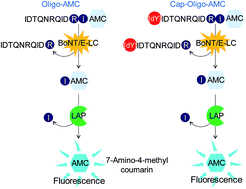One label-based fluorescence detection of a protease that cleaves the peptide bond between two specific amino acids†
Abstract
In order to detect a protease that cleaves the peptide bond between two specific amino acids via fluorescence, a synthetic peptide modified with two labels (a donor and an acceptor) for fluorescence resonance energy transfer (FRET) is commonly used. However, the preparation and optimization of a peptide for the sensitive and selective detection of a target protease are time-consuming. In this study, we report a simple method for fluorescence protease detection using a readily prepared, one label-based peptide. The fluorescence detection of botulinum neurotoxin type E light chain (BoNT/E-LC) is based on a two-step proteolytic cleavage that involves the use of BoNT/E-LC and an externally supplemented L-leucine-aminopeptidase (LAP). BoNT/E-LC cleaves the specific peptide bond between arginine and isoleucine within C-terminally 7-amino-4-methylcoumarin (AMC)-labeled oligopeptide, leaving fragmented isoleucine–AMC. Subsequently, LAP cleaves the peptide bond between isoleucine and AMC, liberating fluorescent AMC. This method does not require two label-modified peptides. Capping the oligopeptide with the D-form of tyrosine does not result in better performance in terms of detection limit, although a higher concentration of LAP can be used. The detection limit for BoNT/E-LC in both phosphate-buffered saline and commercial bottled water is 2 ng mL−1 for an incubation period of 1 h. The fluorescence detection is selective for BoNT/E-LC among the four tested BoNTs. Fluorescence detection using one label can be readily applied to any type of proteases without using FRET.



 Please wait while we load your content...
Please wait while we load your content...